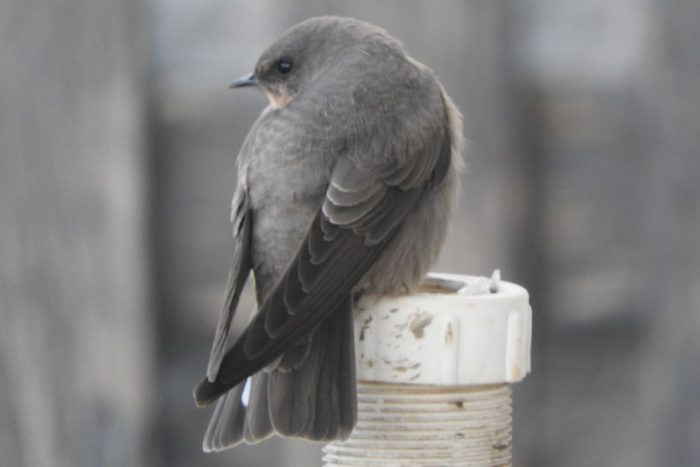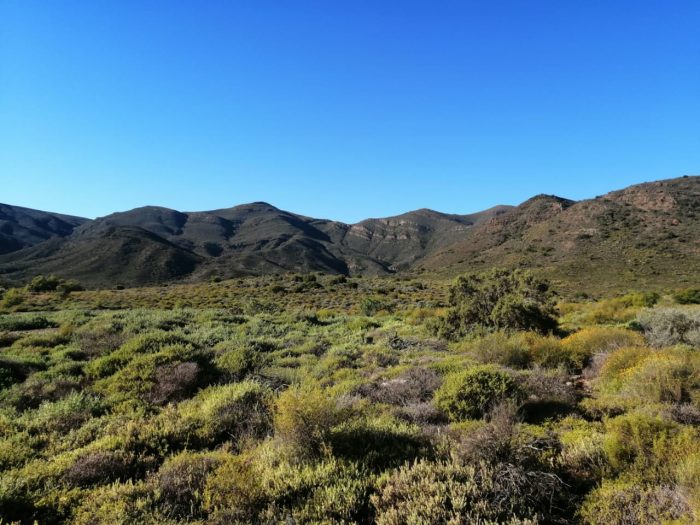A cold and sometimes wet Karoo week was not the best for a ringing course, yet everyone thoroughly enjoyed the course! We caught 219 birds of 29 species at the Ouberg bird ringing course of May 2023, including lots of recaptures, enjoyed wonderful meals, and great camaraderie.
The course was part of a series of bird ringing courses run by the Biodiversity and Development Institute. The overall aim and structure of these events is described here. Future courses are listed under “Upcoming BDI Events” and you are welcome to join. The purpose of bird ringing is described here.

The course was held in the foothills of the big mountains north of Montagu, Western Cape. For background to the Ouberg Private Nature Reserve and its objectives, listen to this conference presentation. Ouberg is a good place for birding in general, but it is the species richness we get while ringing makes it a chosen spot for courses! The drainage line in front of the farmhouse (see the drone photo above) is a highway for bird movement, and provides great mist netting sites.
An innovation on this course was to catch five Cape Spurfowl in noose traps – three males and two females (read more here). Only the males have spurs on their legs, making sexing easy. The spur lengths of the three males were 12, 18 and 21 mm and those with longest spurs were the heaviest (around 1 kg).
We were surprised at the number of mousebirds we caught. Mousebirds often escape from the nets. With a good catch, we looked at biometrics – the wing (mean 96.2 mm) of Speckled Mousebird was slightly larger and the tail (mean 206 mm) slightly shorter than these measurements for White-backed Mousebird (mean 92.7 mm and 222 mm respectively).

There were two pairs of Rock Martins roosting on the farm house. They carefully avoided the mist nets, so one was caught by hand on the last morning at dawn, while it was roosting on the rafter of the veranda. Its partner escaped!

Three Olive Thrushes were caught and a Karoo Thrush was seen.

We also caught a relatively large number of tit-babblers, nine Chestnut-vented Warblers and two Layard’s Tit-babblers. The two species are similar in size and plumage; the difference is the colour of the undertail coverts (the “vent”): white in Layard’s and chestnut (of course!) in Chestnut-vented! See the photos below.


The Southern Fiscals consisted of four males and a female.
Cape Sparrows were very common around the farm house. This was the most caught species – 14 males and 24 females (two of the females were recaptured on later days, to make a capture total of 40 birds for the course).

Weavers and waxbills roosted in reeds near the farmhouse, and a good number were caught – six Cape Weavers, 37 Southern Masked Weavers and 14 Common Waxbills. But many flew out in the wrong direction; now we know where we will put mist nets next time! Two male Southern Masked Weavers were in partial breeding plumage.

Recaptures
We have had several bird ringing expeditions to Ouberg Nature Reserve. The first was in October 2020, and the most recent was in February this year! One of the most valuable aspects of repeated ringing at a place are the recaptures of previously ringed birds. These are used to estimate survival rates for species, which are a critical ingredient in discussions about bird species conservation. There were 37 recaptures. Six birds had first been ringed on our initial ringing expedition in October 2020 – Little Rush Warbler, two Cape Robin-chats, Chestnut-vented Tit-babbler, Cape Weaver and a Cape White-eye. A Southern Fiscal and a Cape Sparrow had been ringed on 24 July 2021. Five birds had been ringed in October 2022, and 12 birds had been ringed in February 2023, a few months ago. We have not yet got enough data to start survival analysis studies, but our intention is to keep returning to this really good ringing site.
One aspect of bird biology which is poorly known is the extent of local movement of the resident species. The drainage line at Ouberg provides an opportunity to investigate this. So on two mornings we ringed at little gaps in the riverine bush some distance from the farm house (see the photo near the top of this blog). At the first gap we recaptured a Chestnut-vented Tit-babbler (ringed at the farm house on 23-Oct-20) and a Long-billed Crombec (ringed at farm house on 15-Feb-23). At the second gap we recaptured a Cape Robin-chat (ringed at farm house on 22-Oct-20).
Numbers of birds caught at Ouberg, 10 to 16 May 2023
The species with links in the table below have full descriptions on the BDI website.
| Sp no | Species | Count |
| 181 | Cape Spurfowl | 5 |
| 316 | Cape Turtle Dove | 3 |
| 390 | Speckled Mousebird | 13 |
| 391 | White-backed Mousebird | 20 |
| 432 | Acacia Pied Barbet | 3 |
| 506 | Rock Martin | 1 |
| 543 | Cape Bulbul | 17 |
| 551 | Sombre Greenbul | 1 |
| 581 | Cape Robin-chat | 10 |
| 609 | Little Rush Warbler | 3 |
| 621 | Long-billed Crombec | 1 |
| 622 | Bar-throated Apalis | 1 |
| 638 | Grey-backed Cisticola | 3 |
| 658 | Chestnut-vented Warbler | 9 |
| 659 | Layard’s Warbler | 2 |
| 665 | Fiscal Flycatcher | 3 |
| 686 | Cape Wagtail | 1 |
| 707 | Southern Fiscal | 5 |
| 760 | Southern Double-collared Sunbird | 2 |
| 784 | House Sparrow | 1 |
| 786 | Cape Sparrow | 40 |
| 799 | Cape Weaver | 6 |
| 803 | Southern Masked Weaver | 37 |
| 843 | Common Waxbill | 14 |
| 867 | Streaky-headed Canary | 1 |
| 873 | Cape Bunting | 1 |
| 1105 | Olive Thrush | 3 |
| 1172 | Cape White-eye | 12 |
| 4139 | Karoo Prinia | 1 |
| TOTAL | 219 |

Thanks to Sue and Richard Gie for hosting us for Ouberg bird ringing course of May 2023! Thanks to Jon and Maite for preparing wonderful meals throughout the course!




The Ouberg bird ringing course of May 2023 was a really good event!

